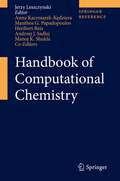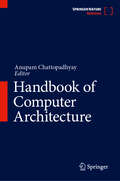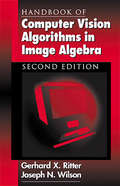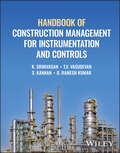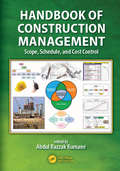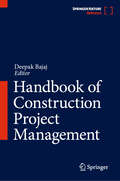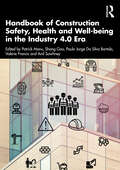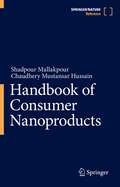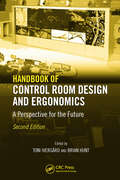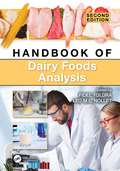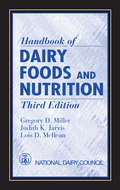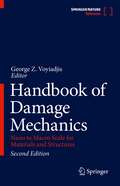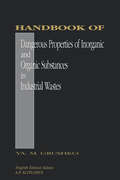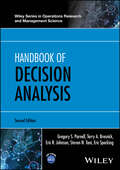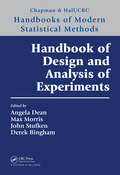- Table View
- List View
Handbook of Computational Chemistry
by Jerzy LeszczynskiThe role the Handbook of Computational Chemistry is threefold. It is primarily intended to be used as a guide that navigates the user through the plethora of computational methods currently in use; it explains their limitations and advantages; and it provides various examples of their important and varied applications. This reference work is presented in three volumes. Volume I introduces the different methods used in computational chemistry. Basic assumptions common to the majority of computational methods based on molecular, quantum, or statistical mechanics are outlined and special attention is paid to the limits of their applicability. Volume II portrays the applications of computational methods to model systems and discusses in detail molecular structures, the modelling of various properties of molecules and chemical reactions. Both ground and excited states properties are covered in the gas phase as well as in solution. This volume also describes Nanomaterials and covers topics such as clusters, periodic, and nano systems. Special emphasis is placed on the environmental effects of nanostructures. Volume III is devoted to the important class of Biomolecules. Useful models of biological systems considered by computational chemists are provided and RNA, DNA and proteins are discussed in detail. This volume presents examples of calcualtions of their properties and interactions and reveals the role of solvents in biologically important reactions as well as the structure function relationship of various classes of Biomolecules.
Handbook of Computer Architecture
by Anupam ChattopadhyayThis handbook presents the key topics in the area of computer architecture covering from the basic to the most advanced topics, including software and hardware design methodologies. It will provide readers with the most comprehensive updated reference information covering applications in single core processors, multicore processors, application-specific processors, reconfigurable architectures, emerging computing architectures, processor design and programming flows, test and verification. This information benefits the readers as a full and quick technical reference with a high-level review of computer architecture technology, detailed technical descriptions and the latest practical applications.
Handbook of Computer Vision Algorithms in Image Algebra
by Joseph N. Wilson Gerhard X. RitterImage algebra is a comprehensive, unifying theory of image transformations, image analysis, and image understanding. In 1996, the bestselling first edition of the Handbook of Computer Vision Algorithms in Image Algebra introduced engineers, scientists, and students to this powerful tool, its basic concepts, and its use in the concise representation
Handbook of Construction Management for Instrumentation and Controls
by K. Srinivasan T.V. Vasudevan S. Kannan D. Ramesh KumarHANDBOOK OF CONSTRUCTION MANAGEMENT FOR INSTRUMENTATION AND CONTROLS Learn to effectively install and commission complex, high-performance instrumentation and controls in modern process plants In Handbook of Construction Management for Instrumentation and Controls, a team of experienced engineers delivers an expert discussion of what is required to install and commission complex, high-performance instrumentation and controls. The authors explain why, despite the ubiquitous availability of diverse international standards and instrument manufacturer data, the effective delivery of such projects involves significantly more than simply fitting instruments on panels. The book covers material including site management, administration, operations, site safety, material management, workforce planning, instrument installation and cabling, instrument calibration, loop check and controller tuning, results recording, and participation in plant commissioning exercises. It also provides an extensive compendium of forms and checklists that can be used by professionals on a wide variety of installation and commissioning projects. Handbook of Construction Management for Instrumentation and Controls also offers: A thorough introduction to site operations, including the principles of equipment installation and testing Comprehensive explorations of quality assurance and quality control procedures from installation to pre-commissioning to site hand-over Practical discussions of site administration and operations, including planning and scheduling, site safety, and contractor permits-to-work, change and delay management Detailed discussion of the installation and commissioning of complex instrumentation and control equipment Perfect for specialty contractors and subcontractors, general contractors, consulting engineers, and construction managers, and as a reference book for institutes teaching courses on Industrial Instrumentation, Handbook of Construction Management for Instrumentation and Controls will also benefit students looking for a career in instrument installation.
Handbook of Construction Management: Scope, Schedule, and Cost Control (Systems Innovation Book Series)
by Abdul Razzak RumaneThe book is developed to provide significant information and guidelines to construction and project management professionals (owners, designers, consultants, construction managers, project managers, supervisors, contractors, builders, developers, and many others from the construction-related industry) involved in construction projects (mainly civil construction projects, commercial-A/E projects) and construction-related industries. It covers the importance of construction management principles, procedures, concepts, methods, and tools, and their applications to various activities/components/subsystems of different phases of the life cycle of a construction project. These applications will improve the construction process in order to conveniently manage the project and make the project most qualitative, competitive, and economical. It also discuss the interaction and/or combination among some of the activities/elements of management functions, management processes, and their effective implementation and applications that are essential throughout the life cycle of project to conveniently manage the project. This handbook will: Focus on the construction management system to manage construction projects Include a number of figures and tables which will enhance reader comprehension Provide all related topics/areas of construction management Be of interest to all those involved in construction management and project management Provide information about Building Information Modeling (BIM), and ISO Certification in Construction Industry Offer a chapter on Lean construction The construction project life cycle phases and its activities/elements/subsystems are comprehensively developed and take into consideration Henri Fayol's Management Function concept which was subsequently modified by Koontz and O'Donnel and Management Processes Knowledge Areas described in PMBOK® published by Project Management Institute (PMI). The information available in the book will also prove valuable for academics/instructors to provide construction management/project management students with in-depth knowledge and guidelines followed in the construction projects and familiarize them with construction management practices.
Handbook of Construction Project Management
by Deepak BajajThis handbook is designed to serve as a comprehensive guide tailored to managing construction projects within the unorganized sector, which is often characterized by small-scale, informal operations that lack structured management practices. This handbook places a special emphasis on emerging economies, where the unorganized sector plays a significant role in the construction industry. This book aims to provide a robust foundation in construction project management by covering essential principles and practices necessary for effective project management. It focuses on offering practical solutions and strategies to improve project delivery, cost management, and operational efficiency within the unorganized sector. Additionally, the book emphasizes sustainability and the integration of innovative technologies, promoting green practices and digital transformation. By adopting a holistic approach, it incorporates socioeconomic considerations, stakeholder engagement, and capacity building to foster improvements across the sector. Real-world case studies and examples are included to illustrate the successful application of various methodologies and highlight lessons learned. Content from this book can also be used to supplement classroom teaching for courses related construction project management and the building construction profession aimed and practicing building engineers, construction professionals and even architects. The contents of this book will be useful to researchers, academics, and practitioners alike.
Handbook of Construction Safety, Health and Well-being in the Industry 4.0 Era
by Shang Gao Patrick Manu Anil Sawhney Valerie Francis Paulo Jorge Da Silva BartoloThis Handbook seeks to examine and advance current understanding of the confluence of construction health, safety and well-being and the broad range of Industry 4.0 technologies in use in the architecture, engineering and construction (AEC) industry. Globally, the construction sector accounts for more than 100,000 occupational fatalities annually. In many countries, reports of work-related accidents, injuries and illnesses are commonplace, and there is an urgent need to improve the occupational safety and health (OSH) outlook of the construction sector. The fourth industrial revolution presents opportunities to leverage modern technologies (e.g., big data, artificial intelligence, automation, sensors, AR, VR and robotics) to improve the poor OSH performance of the construction industry. However, embracing such technologies could also induce unintended adverse consequences for the safety, health and well-being of construction workers. Therefore, the realisation of the opportunities as well as the mitigation of potentially adverse consequences requires research-informed holistic insights around the union of Industry 4.0 and construction occupational safety and health management. This cutting-edge volume addresses a significant gap in literature by bringing together experienced academics and researchers to highlight the drivers, opportunities and drawbacks of the merging of Industry 4.0 with construction health, safety and well-being. After a detailed introductory section which highlights key issues and challenges, section one covers the application of a broad range of digital technologies; then section two discusses the application of industrial production and cyber physical systems in the context of construction safety and health management. Readers from a broad range of AEC backgrounds as well as safety professionals and technologists will come to understand how the technologies are applied and the resulting OSH benefits as well as potential drawbacks.
Handbook of Consumer Behavior, Tourism, and the Internet
by Juline Mills Rob LawMake the most of your online business resources The growing acceptance and use of the Internet as an increasingly valuable travel tool has tourism and hospitality businesses taking a critical look at their business-to-customer online environments while pondering such questions as, "How do I get people to visit my Web site?" "Is my Web site attracting the &’right&’ kind of e-consumers?" and "How do I turn browsers into buyers?" The Handbook of Consumer Behavior, Tourism, and the Internet analyzes the latest strategies involving Internet business applications that will help you attract-and keep-online travel customers. Researchers from the United States, Europe, and Asia present the latest findings you need to make the right decisions regarding long-term e-commerce development and planning.The Handbook of Consumer Behavior, Tourism, and the Internet examines vital issues affecting the travel and tourism industry from an online perspective. This book analyzes the latest theory and research on general online buyer characteristics, the differences between online and offline consumer behavior, the differences between broadband and narrowband users, the online search process, quality and perception of lodging brands, and Web site design, maintenance, and development. Each section of the book includes a model/diagram that serves as an overview of the topic, followed by a thorough discussion on the topic from several sources. Each section ends with commentary on the areas where future research is needed. The book&’s contributors use a variety of research methodologies ranging from qualitative data analyses using artificial neutral network analysis, to experimental design, non-parametric statistical tests, and structural equation modeling. Topics examined in the Handbook of Consumer Behavior, Tourism, and the Internet include: the need for businesses to use internal examinations to determine and meet online consumer needs the emerging field of e-complaint behavior-consumers taking to the Web to voice complaints about travel services how to use e-tools to measure guest satisfaction how to measure consumer reaction to Web-based technology the Internet&’s impact on decision making for travel products and how to use e-mail marketing, electronic customer relationship management (eCRM), Web positioning, and search engine placementThe Handbook of Consumer Behavior, Tourism, and the Internet is equally valuable as a classroom resource or professional reference, providing up-to-date material on Internet applications and their impact on consumers and e-commerce.
Handbook of Consumer Nanoproducts
by Chaudhery Mustansar Hussain Shadpour MallakpourThis handbook provides a best study and practice guide to consumer nanoproducts (scientists, researchers, engineers, experts), and specialists. It captures all aspects of applications of nanotechnology in consumer products, like in healthcare and fitness, home and garden, automotive, appliances, coatings, electronics, foods & beverages, sporting goods, clothing, bikes, touch screens, and automobiles, etc. It is detailed reference material for both the research community and industry professionals wanting to learn about the concept of nanoproduct. Drawing on expert contributors from around the world, this volume provides academia and industry, a high-tech start-up that will revolutionize modern consumer nanoproducts practices. In addition, it also captures aspects of environmental, legal, health, and safety issues related to consumer nano products.
Handbook of Contract Management in Construction
by Ali D. HaidarThis book addresses the process and principles of contract management in construction from an international perspective. It presents a well-structured, in-depth analysis of construction law doctrines necessary to understand the fundamentals of contract management. The book begins with an introduction to contract management and contract law and formation. It then discusses the various parties to a contract and their relevant obligations, whether they are engineers, contractors or subcontractors. It also addresses standard practices when drafting and revising contracts, as well as what can be expected in standard contracts general clauses. Two chapters are dedicated to contract clauses, with one focused on contract administration such as schedules, payment certificates and defects liability, and the other focused on contract management, such as terminations, dispute resolutions and claims. This book provides a useful reference to engineers, project managers and students within the field of engineering and construction management.
Handbook of Control Room Design and Ergonomics: A Perspective for the Future, Second Edition
by Brian Hunt Toni IvergârdFirst published two decades ago, the first edition of Handbook of Control Room Design and Ergonomics: A Perspective for the Future became a benchmark for the field. Current-day process control encompasses a new generation of computer systems with enormous capabilities, including new display technologies. These new and emerging technologies integrat
Handbook of Copper Compounds and Applications
by H. Wayne RichardsonEmphasizing the utility of copper-related compounds, this text illustrates the numerous current and potential uses from agricultural bactericides and wood preservatives to colourants and solar cells. It discusses the properties and behaviour of the copper ion, copper compounds' employment in organic polymerization and isomerization reactions, the e
Handbook of Coriander (Coriandrum sativum): Chemistry, Functionality, and Applications
by Mohamed Fawzy RamadanCoriander (Coriandrum sativum L., family Umbelliferae/Apiaceae) is one of the most popular spices globally. Different parts of Coriandrum sativum are edible and widely used as a seasoning due to their unique flavor and aroma. Coriandrum sativum medical uses have been recognized since ancient times. Coriander leaves (cilantro) and coriander fruit (seed) are used in different ethnic foodstuffs, meat and poultry dishes, soup, pudding, bread, and seafood dishes. Coriandrum sativum is rich in linalool, vitamin A, vitamin B12, vitamin C, folate, and phenolics. Coriandrum sativum fixed oil is rich in sterols, tocols, and bioactive phytochemicals. Petroselinic acid is the major fatty acid in Coriandrum sativum fixed oil and exhibits health-promoting traits. Coriandrum sativum is recommended as a food preservative to replace synthetic antioxidants because of its antioxidant and antibacterial traits. Furthermore, Coriandrum sativum cilantro and seeds are rich in water-soluble and lipid-soluble phytochemicals that showed unique anticancer, anxiolytic, neuroprotective, migraine-relieving, hypoglycemic, hypolipidemic, anticonvulsant, analgesic, and anti-inflammatory traits. Those medical benefits and their integration into daily life render Coriandrum sativum an excellent functional food. Regarding the cosmetic industry, Coriandrum sativum is used as an ingredient in conventional Ayurvedic cosmetic formulations to normalize skin color. In addition, Coriandrum sativum volatile oil finds use as an ingredient in perfumes. Handbook of Coriander (Coriandrum sativum): Chemistry, Functionality, and Applications is a valuable resource for pharmaceutical and nutraceutical developers, as well as novel food developers and R&D researchers in a variety of fields that use herbs, spices, and medicinal plants. Key Features: Explores the chemistry of Coriandrum sativum phytochemicals, oils, and extracts Discusses Coriandrum sativum active constituents and their health-enhancing traits Presents the applications of Coriandrum sativum phytochemicals, oils, and extracts Addresses the growing application areas, including horticulture, functional food, clinical nutrition, pharmaceuticals, and cosmetics Authored by international scientists and industry experts, this book is a great resource for food chemistry, clinical nutrition, biochemistry, pharmacology, and horticulture researchers and students, as well as developers of novel food, cosmetics, and pharmaceuticals, in addition to R&D researchers in different sectors that utilize herbs, spices, and medical plants.
Handbook of Cucurbits: Growth, Cultural Practices, and Physiology
by Mohammad PessarakliThe Handbook of Cucurbits: Growth, Cultural Practices, and Physiology contains information on cultural practices, nutrition, and physiological processes of cucurbits under both normal and stressful conditions. It presents the history and importance of cucurbit crop production as well as exhaustive information on growth responses of cucurbits to var
Handbook of DNA Forensic Applications and Interpretation
by Amit Kumar G. K. Goswami Edwin HuffineThis handbook covers tested and proven DNA forensic testing methodologies, forensic bioinformatics techniques, case studies and current forensic legal framework for investigation of variety of crimes and provides a clinching evidence for speedy justice. DNA testing is widely used for forensic purposes and is changing the paradigm of (crime) investigation. The book contains chapters on usage of ultramodern DNA collection kits, presents era evidence collection and preservation, high-end DNA sample analysis in laboratory, DNA legislation, expert evidences, challenging and successful case studies, data generation and application of AI and IoT techniques for DNA data analysis, DNA databanks and training manpower to facilitate timely reporting to the requesting agencies. This handbook equips and enables police, investigators and crime analysis laboratories with knowhow of high-end tools, procedures and techniques to link or exclude a criminal to a crime. It is expected that this will be used by first responders, police, forensic analysts, judiciaries, evidence handlers and students and scholars of criminology and forensic sciences worldwide. The intention to write this handbook is to make DNA technology and its importance reach every common man and professional for correctly using it as a tool as and when required. This is quite evident that awareness of DNA technology has increased at a reasonable pace. Courts and investigating agencies are convinced and confident with its accuracy, reliability and unmatched peace delivered by various techniques of DNA fingerprinting and DNA profiling.
Handbook of Dairy Foods Analysis
by Fidel Toldrá Leo M.L. NolletDairy foods account for a large portion of the Western diet, but due to the potential diversity of their sources, this food group often poses a challenge for food scientists and their research efforts. Bringing together the foremost minds in dairy research, Handbook of Dairy Foods Analysis, Second Edition, compiles the top dairy analysis techniques and methodologies from around the world into one well-organized volume. Exceptionally comprehensive in both its detailing of methods and the range of dairy products covered, this handbook includes tools for analyzing chemical and biochemical compounds and also bioactive peptides, prebiotics, and probiotics. It describes noninvasive chemical and physical sensors and starter cultures used in quality control. This second edition includes four brand-new chapters covering the analytical techniques and methodologies for determining bioactive peptides, preservatives, activity of endogenous enzymes, and sensory perception of dairy foods, and all other chapters have been adapted to recent research. All other chapters have been thoroughly updated. Key Features: Explains analytical tools available for the analysis of the chemistry and biochemistry of dairy foods Covers a variety of dairy foods including milk, cheese, butter, yogurt, and ice cream Analysis of nutritional quality includes prebiotics, probiotics, essential amino acids, bioactive peptides, and healthy vegetable-origin compounds Includes a series of chapters on analyzing sensory qualities, including color, texture, and flavor. Covering the gamut of dairy analysis techniques, the book discusses current methods for the analysis of chemical and nutritional compounds, and the detection of microorganisms, allergens, contaminants, and/or other adulterations, including those of environmental origin or introduced during processing. Other methodologies used to evaluate color, texture, and flavor are also discussed. Written by an international panel of distinguished contributors under the editorial guidance of renowned authorities, Fidel Toldrá and Leo M.L. Nollet, this handbook is one of the few references that is completely devoted to dairy food analysis – an extremely valuable reference for those in the dairy research, processing, and manufacturing industries.
Handbook of Dairy Foods and Nutrition
by Gregory D. Miller Judith K. Jarvis Lois D. McBeanHandbook of Dairy Foods and Nutrition, Third Edition examines the role of dairy products in diet and health, covering such areas as cardiovascular health, hypertension, cancer, bone, and oral health. This edition features a new chapter on dairy foods and weight management. Other chapters address lactose digestion and the contribution of dairy foods to health throughout the lifecycle. All chapters contain updated (or new) data, content, and references. With peer-reviewed chapters by nutrition and medical experts, this book remains the most subsidized reference on dairy and nutrition currently available.
Handbook of Damage Mechanics: Nano to Macro Scale for Materials and Structures
by George Z. VoyiadjisThis second edition adds newly established techniques and material properties codified in the past ten years to this authoritative reference. The volume retains its comprehensive coverage of damage and healing mechanics with updates to core topics and references and addition of other types of damages not covered in the first edition, including thermo-elastoviscoplastic damage-healing model for bituminous materials, damage in granular materials, damage in biological tissue, damage in rubber materials, damage crashworthiness in cars and airplanes, risk analysis in damaged structures, and evaluating damage with digital image correlation. The Handbook details computational modeling of constitutive equations as well as solved examples in engineering applications. A wide range of materials that engineers may encounter are covered, including metals, composites, ceramics, polymers, biomaterials, and nanomaterials. The internationally recognized team of contributors employs a consistent and systematic approach, offering readers a user-friendly reference that is ideal for frequent consultation. The Handbook of Damage Mechanics: Nano to Macro Scale for Materials and Structures, second edition is ideal for graduate students and faculty, researchers, and professionals in the fields of Mechanical Engineering, Civil Engineering, Aerospace Engineering, Materials Science, and Engineering Mechanics.
Handbook of Dangerous Properties of Inorganic And Organic Substances in Industrial Wastes
by Ya. M. GrushkoA dangerous byproduct of industrial progress is often an increase of pollutants discharged into the environment. These pollutants are often harmful to plants and animals, including humans. They also damage buildings and architectural and cultural monuments. This handbook describes many of the important physico-chemical properties of inorganic and organic substances found in industrial wastes and describes their toxic effects on humans.
Handbook of Decision Analysis
by Gregory S. Parnell Eric R. Johnson Terry Bresnick Steven N. TaniA ONE-OF-A-KIND GUIDE TO THE BEST PRACTICES IN DECISION ANALYSISDecision analysis provides powerful tools for addressing complex decisions that involve uncertainty and multiple objectives, yet most training materials on the subject overlook the soft skills that are essential for success in the field. This unique resource fills this gap in the decision analysis literature and features both soft personal/interpersonal skills and the hard technical skills involving mathematics and modeling.Readers will learn how to identify and overcome the numerous challenges of decision making, choose the appropriate decision process, lead and manage teams, and create value for their organization. Performing modeling analysis, assessing risk, and implementing decisions are also addressed throughout. Additional features include:Key insights gleaned from decision analysis applications and behavioral decision analysis researchIntegrated coverage of the techniques of single- and multiple-objective decision analysisMultiple qualitative and quantitative techniques presented for each key decision analysis taskThree substantive real-world case studies illustrating diverse strategies for dealing with the challenges of decision makingExtensive references for mathematical proofs and advanced topicsThe Handbook of Decision Analysis is an essential reference for academics and practitioners in various fields including business, operations research, engineering, and science. The book also serves as a supplement for courses at the upper-undergraduate and graduate levels.
Handbook of Decision Analysis (Wiley Series in Operations Research and Management Science)
by Gregory S. Parnell Eric R. Johnson Steven N. Tani Terry A. Bresnick Eric SpeckingQualitative and quantitative techniques to apply decision analysis to real-world decision problems, supported by sound mathematics, best practices, soft skills, and more With substantive illustrations based on the authors’ personal experiences throughout, Handbook of Decision Analysis describes the philosophy, knowledge, science, and art of decision analysis. Key insights from decision analysis applications and behavioral decision analysis research are presented, and numerous decision analysis textbooks, technical books, and research papers are referenced for comprehensive coverage. This book does not introduce new decision analysis mathematical theory, but rather ensures the reader can understand and use the most common mathematics and best practices, allowing them to apply rigorous decision analysis with confidence. The material is supported by examples and solution steps using Microsoft Excel and includes many challenging real-world problems. Given the increase in the availability of data due to the development of products that deliver huge amounts of data, and the development of data science techniques and academic programs, a new theme of this Second Edition is the use of decision analysis techniques with big data and data analytics. Written by a team of highly qualified professionals and academics, Handbook of Decision Analysis includes information on: Behavioral decision-making insights, decision framing opportunities, collaboration with stakeholders, information assessment, and decision analysis modeling techniques Principles of value creation through designing alternatives, clear value/risk tradeoffs, and decision implementation Qualitative and quantitative techniques for each key decision analysis task, as opposed to presenting one technique for all decisions. Stakeholder analysis, decision hierarchies, and influence diagrams to frame descriptive, predictive, and prescriptive analytics decision problems to ensure implementation success Handbook of Decision Analysis is a highly valuable textbook, reference, and/or refresher for students and decision professionals in business, management science, engineering, engineering management, operations management, mathematics, and statistics who want to increase the breadth and depth of their technical and soft skills for success when faced with a professional or personal decision.
Handbook of Deep Learning Models for Healthcare Data Processing: Disease Prediction, Analysis, and Applications (Advancements in Intelligent and Sustainable Technologies and Systems)
by Ajay Kumar Surbhi Bhatia Khan Deepak Dembla Seema TinkerIn recent years, deep learning has shown great potential in transforming various fields including healthcare. With the abundance of healthcare data being generated every day, there is a pressing need to develop efficient algorithms that can process and analyze this data to improve patient care and treatment outcomes.Handbook of Deep Learning Models for Healthcare Data Processing: Disease Prediction, Analysis, and Applications covers a wide range of deep learning models, techniques, and applications in healthcare data processing, analysis, and disease prediction, providing a comprehensive overview of the field. It focuses on the practical application of deep learning models in healthcare and offers step-by-step instructions for building and deploying models and using real-world examples. The handbook discusses the potential future applications of deep learning models in healthcare, such as precision medicine, personalized treatment, and clinical decision support. It also addresses the ethical considerations associated with the use of deep learning models in healthcare, such as privacy, security, and bias. It provides technical details on deep learning models, including their architecture, training methods, and optimization techniques, making it useful for data scientists and researchers.Written to be a comprehensive guide for healthcare professionals, researchers, and data analysts, this handbook is an essential need for those who are interested in using deep learning models to analyze and process healthcare data. It is also suitable for those who have a basic understanding of machine learning and want to learn more about the latest advancements in deep learning in healthcare.
Handbook of Design and Analysis of Experiments (Chapman & Hall/CRC Handbooks of Modern Statistical Methods)
by Max Morris Angela Dean John Stufken Derek BinghamThis carefully edited collection synthesizes the state of the art in the theory and applications of designed experiments and their analyses. It provides a detailed overview of the tools required for the optimal design of experiments and their analyses. The handbook covers many recent advances in the field, including designs for nonlinear models and algorithms applicable to a wide variety of design problems. It also explores the extensive use of experimental designs in marketing, the pharmaceutical industry, engineering and other areas.
Handbook of Design and Industry: Scenarios for Sustainable Futures
by Rita Assoreira Almendra Maria João Félix Fátima Pombo Moreira da Silva, Fernando Jorge de Sousa Cruz, PauloThe twenty-first century has been beset by a global pandemic, war and increasingly concerning environmental disasters. Designers and industries have been forced to imagine a world in which the only way to move forward is to look back. The design and industry sectors need to understand the role they can play in removing obstacles to social progress and work together to create healthier human societies that can interact with the world in a sustainable way.This book presents contributions from leading experts that reveal that a better and more prosperous world is achievable through good work and system design. This book consists of chapters that bring together researchers, academics, policy makers, and designers from technology companies and business associations with the objective of developing a focused vision that enhances innovation through design and industry for a better future. Through a transdisciplinary scientific exchange, it lists responses to the challenges of climate change and environmental degradation that will contribute to a more modern, resource-efficient, competitive economy, with smart, sustainable, and inclusive growth, promoting knowledge, inter-sector collaboration, health, education and a digital society for all. By putting the human at the heart of what can be accomplished, this book investigates better design in the disciplines of work, healthcare, product, system, manufacturing, and industry. The reader will gather an interdisciplinary perspective on what good design can achieve and why it is needed to challenge the climate crisis.The Handbook of Design and Industry: Scenarios for Sustainable Futures is essential reading for researchers and academics in the fields and disciplines of ergonomics/human factors, occupational health and safety, industrial design, product design, industrial engineering, materials engineering, process engineering, computer engineering, communication design, electronics and telecommunications engineering.
Handbook of Detergents, Part E: Applications (Surfactant Science)
by Uri ZollerAn Examination of Detergent ApplicationsThe fifth volume in a six volume project penned by detergent industry experts, this segment deals with the various applications of detergent formulations - surfactants, builders, sequestering/chelating agents - as well as other components. These applications are discussed with respect to the scope
